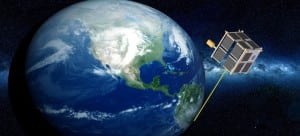Latest News
[Via Satellite 02-12-2016] ExactEarth held its first standalone conference call as a public company after its spinout from Com Dev concluded. During the call, CEO Peter Mabson laid out plans to expand its Satellite Automatic Identification (AIS) System data services. As exactEarth steps out on its own, the company reported a 68 percent increase in revenue from 2014, with total revenue reaching $19.2 million, but warned about slowing revenues in the coming year.
Subscription services boosted 2015 revenue, which represented 77 percent of total revenues, and offered profits of $14.9 million in 2015, compared to $9.1 million in 2014. ExactEarth’s subscriber base grew to 130 customers in 40 countries. The subscription revenue boost is largely due to a $13 million, 18-month contract with the Canadian government for AIS maritime vessel tracking services, which more than doubled the run rate with the government, exactEarth CFO Sean Maybee told investors and journalists Feb. 5, on the conference call.
The increase proved to be the single largest contributor to the revenue lift, but with the current contract set to expire at the end of March, the company could face competition from other AIS providers as the market gets more competitive, Maybee noted during the call. Although Maybee is “confident” exactEarth will pick up the government contract again, it is likely the size and value could be considerably smaller.
“A significant portion of the scope of the contract, namely CA$7.5 million [$5.4 million] over the 18 month period, is related to Canada providing AIS services to certain foreign governments. At this time, it is uncertain whether the government intends to continue with that portion, therefore there is the potential for the value of the contract to be reduced,” said Maybee. The company expects the Canadian government’s decision to fall in the second quarter at the end of March to coincide with the completion of the current contract.
A strategic partnership inked with Harris in In June 2015, with a $2.5 million upfront payment, also worked to boost revenues. Under this partnership, Harris became the exclusive provider to the U.S. government of AIS products and services, including exactEarth’s exactAIS product portfolio. The alliance will also extend the exactEarth’s maritime AIS reach worldwide.
“The Harris partnership will assure us access to maritime payloads on 58 satellites in the Iridium Next constellation. That will enable exactEarth to operate continuous, real-time global service,” said Mabson. The payloads cover the Maritime VHF frequency band.
With these two major contracts spiking revenues in 2015, exactEarth anticipates slower growth in the coming year.
“The one-time nature of the Harris payment and the uncertainty over the size of the Canadian contract renewal are expected to impact growth potential in 2016,” Maybee said.
“As we plan for 2016 and beyond we will be executing on not only the growth initiatives we launched over the past 24 months, but now, with the financial injection that we have received, we will begin moving forward on a new set of growth initiatives,” said Mabson. “From an existing growth initiative perspective we will be completing our first generation satellite system and then moving rapidly into our second generation system.”
The company integrated three additional AIS satellites into its first-generation global vessel monitoring constellation with the launch of its first equatorial orbit satellite, exactView 9, which entered operational service on Jan. 18 and will boost the number of satellites in the constellation to eight. The latest satellite launched in September 2015 will be able to provide high performance detection of low power class B AIS transceivers, outfitted with Advanced Class B Satellite Enabled AIS (ABSEA) detection technology, for small vessels.
Additionally, exactEarth anticipates the launch of two additional polar orbiting satellites in the second half of fiscal year 2016 to complete the constellation. The launch has already seen a delay, but Mabson was confident that the company would be able to bring the additional satellites into service for early 2017.
“By the end of 2017 we are likely to have more than 50 assets in orbit and should be approaching a continuous, real-time global service performance level,” said Mabson. The extended capability aims to pave the way for the company to address a boarder range of market applications, including real-time commercial and government vessel tracking markets.
In terms of new growth initiatives, Mabson noted that exactEarth is looking to broaden its scope beyond maritime AIS. The company invested $1.4 million to secure a minority ownership position in Australian technology company, Myriota, which uses advanced signal processing in order to develop terminals, infrastructure and applications for satellite Internet of Things (IoT), in an effort to make a stake in the satellite IoT market. Mabson said exactEarth is interested in providing sensor data and advanced location services through satellite IoT.
Get the latest Via Satellite news!
Subscribe Now